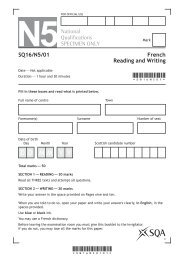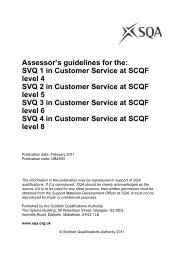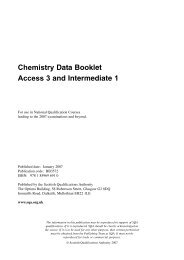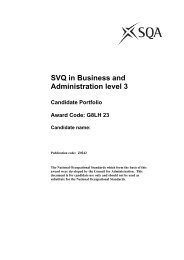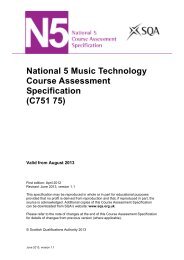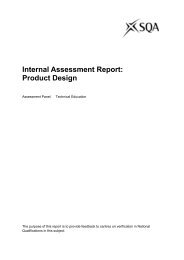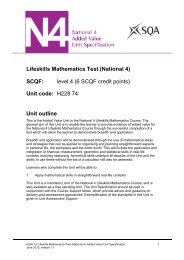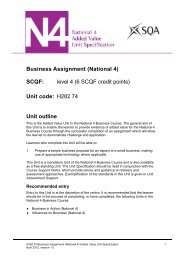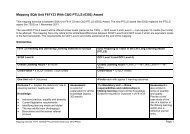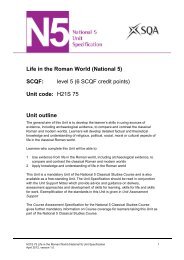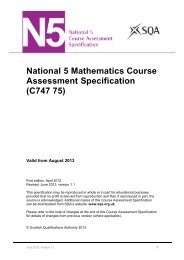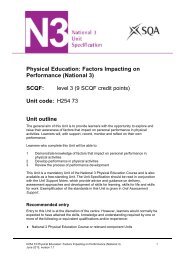Maths H 1,2 stats Spec QP.qxp - SQA
Maths H 1,2 stats Spec QP.qxp - SQA
Maths H 1,2 stats Spec QP.qxp - SQA
You also want an ePaper? Increase the reach of your titles
YUMPU automatically turns print PDFs into web optimized ePapers that Google loves.
[C102/S<strong>QP</strong>249]<br />
Higher<br />
Time: 1 hour 10 minutes<br />
Mathematics<br />
Units 1, 2 and Statistics<br />
Paper 1<br />
(Non-calculator)<br />
<strong>Spec</strong>imen Question Paper (Revised)<br />
for use in and after 2004<br />
NATIONAL<br />
QUALIFICATIONS<br />
Read Carefully<br />
1 Calculators may NOT be used in this paper.<br />
2 Full credit will be given only where the solution contains appropriate working.<br />
3 Answers obtained by readings from scale drawings will not receive any credit.<br />
[C102/S<strong>QP</strong>249] 1<br />
©
FORMULAE LIST<br />
Circle:<br />
The equation x 2 + y 2 + 2gx + 2fy + c = 0 represents a circle centre (–g, –f) and radius<br />
2 2<br />
g + f −c.<br />
The equation (x – a) 2 + (y – b) 2 = r 2 represents a circle centre (a, b) and radius r.<br />
Trigonometric formulae:<br />
sin (A ± B) = sin A cos B ± cos A sin B<br />
cos (A ± B) = cos A cos B<br />
sin A sin B<br />
±<br />
sin 2A = 2sin A cos A<br />
cos 2A = cos 2 A – sin 2 A<br />
= 2cos 2 A – 1<br />
= 1 – 2sin 2 A<br />
Statistics:<br />
Sample standard deviation<br />
2 2<br />
2<br />
i ( i ( i)<br />
)<br />
s = 1<br />
( )<br />
1 1<br />
∑ x x x x<br />
n 1 − = ∑<br />
−<br />
n−1<br />
− ∑<br />
n<br />
where n is the<br />
sample size.<br />
Sums of squares and products:<br />
( )<br />
( )<br />
S x x x<br />
1<br />
∑ ∑ ∑x<br />
n<br />
2 2 2<br />
xx = i − = i − i<br />
( )<br />
( )<br />
S y y y<br />
1<br />
∑ ∑ ∑y<br />
n<br />
2 2 2<br />
yy = i − = i − i<br />
(<br />
)(<br />
)<br />
S = x x y y x y<br />
1<br />
∑ − − = ∑ − ∑x ∑y<br />
n<br />
xy i i i i i i<br />
Linear regression:<br />
The equation of the least squares regression line of y on x<br />
is given by y = α + βx, where estimates for α and β, a and b,<br />
are given by:<br />
a = y−bx<br />
b<br />
(<br />
∑ x −x y − y<br />
i i<br />
= =<br />
2<br />
∑ xi<br />
− x<br />
(<br />
)(<br />
)<br />
)<br />
S<br />
S<br />
xy<br />
xx<br />
Product moment correlation coefficient r:<br />
(<br />
)(<br />
∑<br />
∑( i ) ∑(<br />
i )<br />
xi<br />
−x yi<br />
− y<br />
r = =<br />
x −x y − y<br />
)<br />
S<br />
S S<br />
2 2<br />
xy<br />
xx<br />
yy<br />
[C102/S<strong>QP</strong>249] 2<br />
Page two
All questions should be attempted.<br />
Marks<br />
1. P(–4, 5), Q(–2, –2) and R(4, 1) are the<br />
vertices of triangle PQR as shown in<br />
the diagram. Find the equation of PS,<br />
the altitude from P.<br />
P(–4, 5)<br />
y<br />
(4)<br />
O<br />
R(4, 1)<br />
x<br />
Q(–2, –2)<br />
S<br />
2. A sequence is defined by the recurrence relation u n + 1 = 0 . 3u n + 5 with first<br />
term u 1 .<br />
(a) Explain why this sequence has a limit as n tends to infinity.<br />
(b) Find the exact value of this limit.<br />
(1)<br />
(2)<br />
3. (a) Show that (x – 1) is a factor of f(x) = x 3 – 6x 2 + 9x – 4 and find the other<br />
factors.<br />
(b) Write down the coordinates of the points at which the graph of y = f(x)<br />
meets the axes.<br />
(c) Find the stationary points of y = f(x) and determine the nature of each.<br />
(d) Sketch the graph of y = f(x) .<br />
(4)<br />
(2)<br />
(5)<br />
(1)<br />
4. If x° is an acute angle such that tan x°= , show that the exact value of<br />
3<br />
4 3+<br />
3<br />
sin( x + 30) ° is .<br />
10<br />
4<br />
(4)<br />
[C102/S<strong>QP</strong>249] 3<br />
Page three
5. Class 1A sat a test out of 60. The marks are shown in the stem-and-leaf<br />
diagram below.<br />
Marks<br />
3 7<br />
4 0 1 2 2 4 4<br />
4 5 5 6 7 7 7 8 8 8 9 9 9<br />
5 0 1 1 2 3 4<br />
n = 25 3 7 represents 37<br />
The diagram below shows an incomplete boxplot for this data.<br />
Class 1A<br />
37<br />
P Q R 54<br />
(a) Find the values associated with the points P, Q and R.<br />
(b) The boxplot below shows the data for classes 1B and 1C.<br />
(3)<br />
Class 1C<br />
Class 1B<br />
30 40 50<br />
Compare the results of these two classes.<br />
(2)<br />
[C102/S<strong>QP</strong>249] 4<br />
Page four
6. A bakery firm makes ginger-bread<br />
men each 14 cm high with a circular<br />
“head” and “body”. The equation of<br />
the “body” is x 2 + y 2 – 10x – 12y + 45 = 0<br />
and the line of centres is parallel to the<br />
y-axis.<br />
Find the equation of the “head”.<br />
y<br />
14<br />
Marks<br />
(6)<br />
O<br />
x<br />
7. Find the value of<br />
∫<br />
2 2<br />
1<br />
u + 2<br />
2<br />
2u<br />
du.<br />
(7)<br />
8. Sketch the graph of y = 2sin(x – 30)° for 0 ≤ x < 360.<br />
(4)<br />
[C102/S<strong>QP</strong>249] 5<br />
Page five
9. A random device moves one unit to the right with probability 0 . 3, one unit to<br />
the left with probability 0 . 3 or remains in the same position after each trial.<br />
(a) Tabulate the probability distribution of X, the position of the device, after<br />
one trial.<br />
(b) A calculator produces the following random numbers.<br />
0 . 764 0 . 380 0 . 410 0 . 175 0 . 458<br />
0 . 552 0 . 709 0 . 935 0 . 451 0 . 854<br />
(i) Explain how you would use these numbers to simulate ten trials of<br />
this random experiment.<br />
(ii) List the results of your simulation.<br />
Marks<br />
(2)<br />
(3)<br />
(1)<br />
10. The total lifetime (in years) of 5 year old washing machines of a certain make is<br />
a random variable whose cumulative distribution function F is given by<br />
{<br />
0 for x ≤ 5<br />
Fx ( ) = 25<br />
1 − for x > 5<br />
2<br />
x<br />
(a) Find the probability that such a washing machine will be in service for:<br />
(i) less than 8 years;<br />
(ii) more than 10 years.<br />
(b) Find the probability density function f(x).<br />
(c)<br />
Calculate the exact value of the median lifetime of these washing<br />
machines.<br />
(1)<br />
(2)<br />
(3)<br />
(3)<br />
[END OF SPECIMEN QUESTION PAPER]<br />
[C102/S<strong>QP</strong>249] 6<br />
Page six
[C102/S<strong>QP</strong>249]<br />
Higher<br />
Time: 1 hour 30 minutes<br />
Mathematics<br />
Units 1, 2 and Statistics<br />
Paper 2<br />
<strong>Spec</strong>imen Question Paper (Revised)<br />
for use in and after 2004<br />
NATIONAL<br />
QUALIFICATIONS<br />
Read Carefully<br />
1 Calculators may be used in this paper.<br />
2 Full credit will be given only where the solution contains appropriate working.<br />
3 Answers obtained by readings from scale drawings will not receive any credit.<br />
[C102/S<strong>QP</strong>249] 7<br />
©
FORMULAE LIST<br />
Circle:<br />
The equation x 2 + y 2 + 2gx + 2fy + c = 0 represents a circle centre (–g, –f) and radius<br />
2 2<br />
g + f −c.<br />
The equation (x – a) 2 + (y – b) 2 = r 2 represents a circle centre (a, b) and radius r.<br />
Trigonometric formulae:<br />
sin (A ± B) = sin A cos B ± cos A sin B<br />
cos (A ± B) = cos A cos B<br />
sin A sin B<br />
±<br />
sin 2A = 2sin A cos A<br />
cos 2A = cos 2 A – sin 2 A<br />
= 2cos 2 A – 1<br />
= 1 – 2sin 2 A<br />
Statistics:<br />
Sample standard deviation<br />
2 2<br />
2<br />
i ( i ( i)<br />
)<br />
s = 1<br />
( )<br />
1 1<br />
∑ x x x x<br />
n 1 − = ∑<br />
−<br />
n−1<br />
− ∑<br />
n<br />
where n is the<br />
sample size.<br />
Sums of squares and products:<br />
( )<br />
( )<br />
S x x x<br />
1<br />
∑ ∑ ∑x<br />
n<br />
2 2 2<br />
xx = i − = i − i<br />
( )<br />
( )<br />
S y y y<br />
1<br />
∑ ∑ ∑y<br />
n<br />
2 2 2<br />
yy = i − = i − i<br />
(<br />
)(<br />
)<br />
S = x x y y x y<br />
1<br />
∑ − − = ∑ − ∑x ∑y<br />
n<br />
xy i i i i i i<br />
Linear regression:<br />
The equation of the least squares regression line of y on x<br />
is given by y = α + βx, where estimates for α and β, a and b,<br />
are given by:<br />
a = y−bx<br />
b<br />
(<br />
∑ x −x y − y<br />
i i<br />
= =<br />
2<br />
∑ xi<br />
− x<br />
(<br />
)(<br />
)<br />
)<br />
S<br />
S<br />
xy<br />
xx<br />
Product moment correlation coefficient r:<br />
(<br />
)(<br />
∑<br />
∑( i ) ∑(<br />
i )<br />
xi<br />
−x yi<br />
− y<br />
r = =<br />
x −x y − y<br />
)<br />
S<br />
S S<br />
2 2<br />
xy<br />
xx<br />
yy<br />
[C102/S<strong>QP</strong>249] 8<br />
Page two
All questions should be attempted.<br />
Marks<br />
1. ABCD is a parallelogram. A, B and C have coordinates (2, 3), (4, 7) and<br />
(8, 11). Find the equation of DC.<br />
(4)<br />
2. Trees are sprayed weekly with the pesticide, “Killpest”, whose manufacturers<br />
claim it will destroy 60% of all pests. Between the weekly sprayings, it is<br />
estimated that 300 new pests invade the trees.<br />
A new pesticide, “Pestkill”, comes onto the market. The manufacturers claim<br />
that it will destroy 80% of existing pests but it is estimated that 360 new pests<br />
per week will invade the trees.<br />
Which pesticide will be more effective in the long term?<br />
(6)<br />
3. (a) Show that the function f(x) = 2x 2 + 8x – 3 can be written in the form<br />
f(x) = a(x + b) 2 + c where a, b and c are constants.<br />
(b) Hence, or otherwise, find the coordinates of the turning point of the<br />
function f.<br />
(3)<br />
(1)<br />
4. In the diagram below, a winding river has been modelled by the curve<br />
y = x 3 – x 2 – 6x –2 and a road has been modelled by the straight line AB. The<br />
road is a tangent to the river at the point A(1, –8).<br />
(a) Find the equation of the tangent at A.<br />
(b) Hence find the coordinates of B.<br />
(c)<br />
Find the area of the shaded part which represents the land bounded by<br />
the river and the road.<br />
(4)<br />
(5)<br />
(5)<br />
y<br />
B<br />
O<br />
x<br />
A<br />
[C102/S<strong>QP</strong>249] 9<br />
Page three
5. In an archery competition, the probability that a particular competitor hits<br />
3<br />
the target with any shot is In the competition, she is allowed three shots.<br />
4 .<br />
(a) Find the probability that she hits the target:<br />
(i) exactly twice;<br />
(ii) at least once.<br />
(b) State a statistical assumption that you have made.<br />
Marks<br />
(2)<br />
(2)<br />
(1)<br />
6. A market gardener wishes to investigate the relationship between the total<br />
weight of tomatoes produced by a tomato plant and the amount of fertiliser<br />
used. An experiment was carried out where known amounts of fertiliser were<br />
applied to 8 similar plants. The results are shown in the table.<br />
Weight of fertiliser (g) x 0 2 4 6 8 10 12 14<br />
Tomato yield (kg) y 4 . 44 5 . 13 5 . 45 5 . 27 5 . 81 6 . 04 5 . 90 6 . 23<br />
A scatter diagram shows that a linear model is appropriate.<br />
2<br />
∑ ∑ ∑<br />
You may assume that y = 44 ⋅ 27, y = 247 ⋅ 3665 and xy= 32 8⋅58<br />
(a) Determine the equation of the least squares regression line of y on x.<br />
(b) Calculate the product moment correlation coefficient and comment on<br />
your answer.<br />
(6)<br />
(3)<br />
7. (a) Show that 2cos 2x ° – cos 2 x ° = 1 – 3sin 2 x °.<br />
(b) Hence<br />
(i) write the equation 2cos 2x ° – cos 2 x ° = 2sin x ° in terms of sin x °<br />
(ii) solve this equation in the interval 0 ≤ x < 90.<br />
(3)<br />
(4)<br />
8. The roots of the equation (x – 1)(x + k) = –4 are equal.<br />
Find the values of k.<br />
(5)<br />
[C102/S<strong>QP</strong>249] 10<br />
Page four
9. A window in the shape of a rectangle surmounted by a<br />
semicircle is being designed to let in the maximum<br />
amount of light.<br />
The glass to be used for the semicircular part is stained<br />
glass which lets in one unit of light per square metre;<br />
the rectangular part uses clear glass which lets in 2 units<br />
of light per square metre.<br />
Marks<br />
The rectangle measures 2x metres by h metres.<br />
h metres<br />
2x metres<br />
(a) (i) If the perimeter of the whole window is 10 metres, express h in<br />
terms of x.<br />
(ii) Hence show that the amount of light, L, let in by the window is<br />
2 3 2<br />
given by L = 20x−4 x − πx<br />
.<br />
2<br />
(b) Find the values of x and h that must be used to allow this design to let in<br />
the maximum amount of light.<br />
(2)<br />
(2)<br />
(6)<br />
10. The random variable X has a probability density function<br />
fx ( )<br />
={<br />
kx 2 (1 −x) for 0 ≤ x ≤1<br />
0 otherwise<br />
(a) Find the value of k.<br />
(b) Find the probability that X lies in the range<br />
2<br />
3<br />
0 ≤ X ≤ .<br />
(2)<br />
(4)<br />
[END OF SPECIMEN QUESTION PAPER]<br />
[C102/S<strong>QP</strong>249] 11<br />
Page five
[C102/S<strong>QP</strong>249] 12<br />
[BLANK PAGE]



